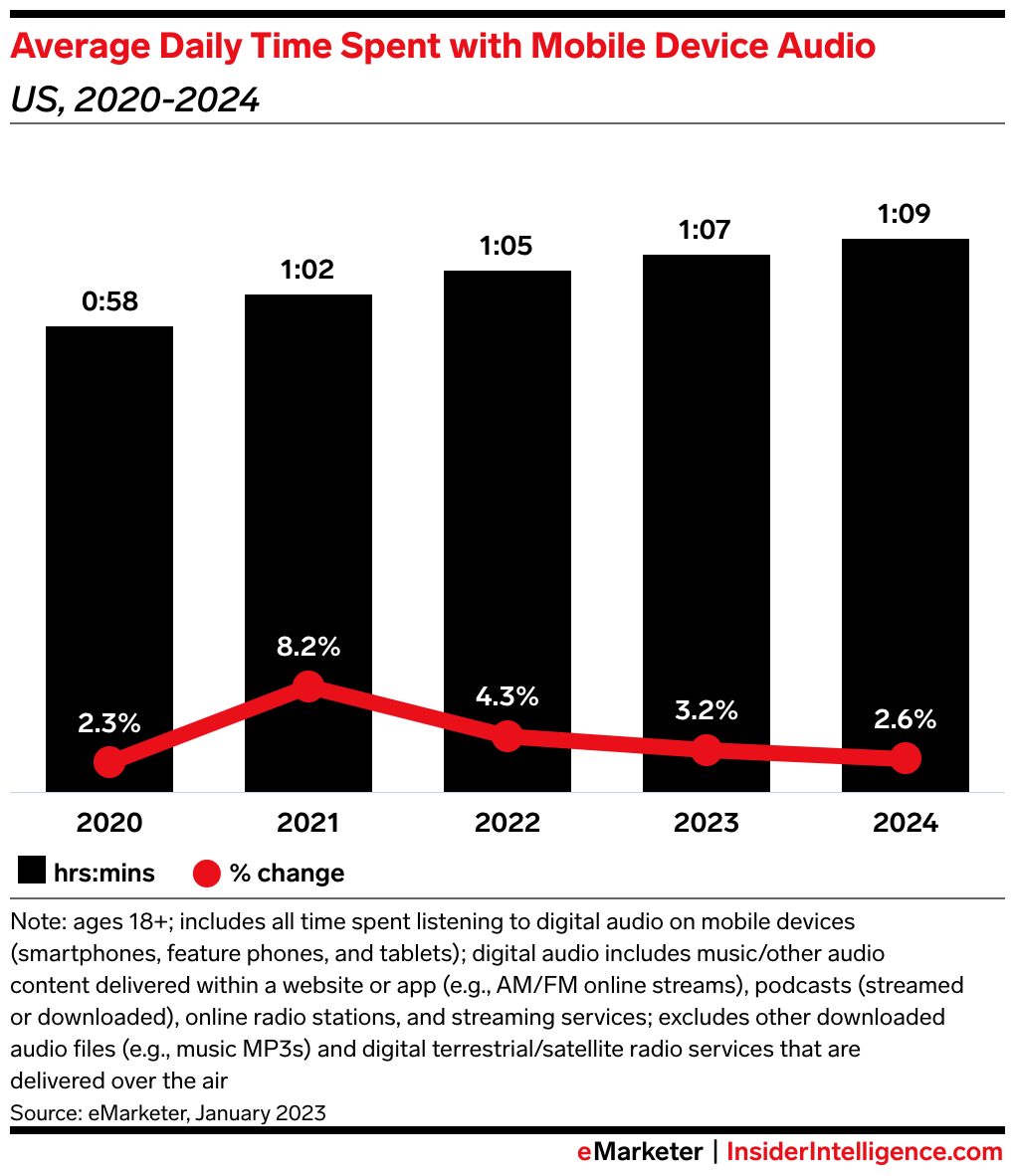There is so much content out there, and consumers are spending more time with media than ever. This makes it both easier to get your message across and harder to stand out. The only solution is to get creative with your strategy.
That’s where audio marketing comes in.
According to Statista, consumers spend an average of 168 minutes a day on audio and 58 minutes a day on podcasts. Audio marketing can be used to drive additional reach and scale for your brand while serving as a complement to your overarching media strategy.
But if your mind immediately turns to jingles and terrible ad reads by radio DJs, you’re missing the bigger picture. So let’s explore the role modern audio marketing can play in your media mix, how ads are served, and the best way to measure performance.
The importance of audio in your media mix
Consumers are spending more time on mobile devices, according to eMarketer. Audio activity is a big driver of mobile usage, and that means there is a growing opportunity to grab the attention of listeners in the audio/podcast space.

Source: eMarketer
TV and other leaned-back media are known as places where consumers are easily distracted, by second screens or other activities, but listeners are often wholly engaged with audio. This high-intent environment makes podcasts an option as both an upper and mid-funnel activation to drive awareness and consideration.
A report by Nielsen revealed that podcast listenership increased by 40% from 2019 to 2022, with 51% of consumers saying they started listening during the pandemic. As new podcasts pop up on the daily, it doesn’t seem like they’re going anywhere anytime soon.
This is excellent news for those looking to diversify their media mix, especially because Nielsen’s Podcast Ad Effectiveness report also noted that podcast ads drove 14 points in brand awareness and 7 points in information seeking.
One of the biggest challenges for marketers just getting into the game is audio’s fragmented landscape. There’s a podcast, show, or playlist for every genre you can think of, and many more besides.
But that also offers the unique opportunity to get very specific and niche with your target audience by serving them the personalized ads they crave against content that feels specific and relevant to their interests.
For those worried about brand safety or concerned that their ad could pop up at an inopportune time, a YouGov survey found that people thought audio advertising was more trustworthy than other ad formats.
An overview of audio ad formats and distribution channels
Like any other campaign, you have to be thoughtful about ad placement and define what you’re trying to accomplish with the podcast or audio ads before putting them out into the universe.
Let’s start with podcast ads: the number of ad spots in a podcast are dependent on the show itself. Placements include pre-roll, mid-roll, and post-roll, and there may be multiple advertiser spots within each of those ad breaks. You have a higher likelihood of catching the consumer’s attention with pre-roll placements; PodSights reports that pre-roll leads for conversion rates at 1.29% compared to mid-roll at 1.18%.
Dynamic ads allow podcast hosts to work with multiple advertisers at any given time, as ads are not hard-coded into their shows. The biggest draw of dynamic ads is the ability to control audience: the ad is inserted into the podcast automatically upon download by a member of your target audience.
A host-read ad is an audio spot where the host uses a script or talking points provided by the advertiser. Host-read ads can be pre-recorded and dynamically inserted into the host’s podcast (or multiple podcasts if the host has more than one podcast).
They can also be read “live” as part of the podcast and last for as long as the podcast exists. The style of host-read should be clarified during the planning phase.

Source: Simon Whistler
A host-read ad feels less intrusive and more organic; these spots can be particularly powerful because the brand has the opportunity to let the podcast host inject their personality into the ad, which can have a halo effect on their listeners. In fact, Nielsen reported that host-reads were shown to drive a 14% higher lift in ad recall than non-host read spots.

Source: Nielsen
You need to be careful if you’re considering going with an unscripted host-read ad with talking points or a live read and make sure that the host’s persona is in line with your brand’s identity. A host may also decline to work with an advertiser if the host does not feel an alignment with the brand.
There are more intensive options. For advertisers that want a higher share of voice, an episode takeover or exclusive sponsorship of a podcast in perpetuity (think of the Mail Chimp sponsorship of the OG viral podcast, Serial) are available for some podcasts, but they come at a higher cost. You need to make sure they’re the right fit for your audience if you’re going down that route, particularly if you’re exploring long-term partnerships.
The power of implementing audio ads
The last thing you want to do with your ad dollars is waste them. That’s why it’s important to have a strong measurement framework in place that incorporates the right metrics for audio ads.
We already know that audio ads are hard to skip and that listeners are more engaged, but there are several critical KPIs that showcase the benefits of an audio strategy:
- Brand lift: The top 10% of brand lift campaigns, according to Nielsen, tend to have nearly three-quarters of their impressions tied to audio.
- In-store visits: According to Foursquare, audio-only campaigns drove a 10.1% lift for in-store visits, compared to 5.3% for multi-format campaigns.
- CPG sales: NC Solutions and Oracle shared that campaigns with a majority of audio impressions tend to outperform other campaign types, driving higher sales lift, ROAS, reach, and frequency.
Unlike traditional radio, digital streaming services offer audience insights into everything from demographics and location to device usage and listening habits. The power of audio can help your brand break through a crowded playing field and truly connect with your consumer.







Responses